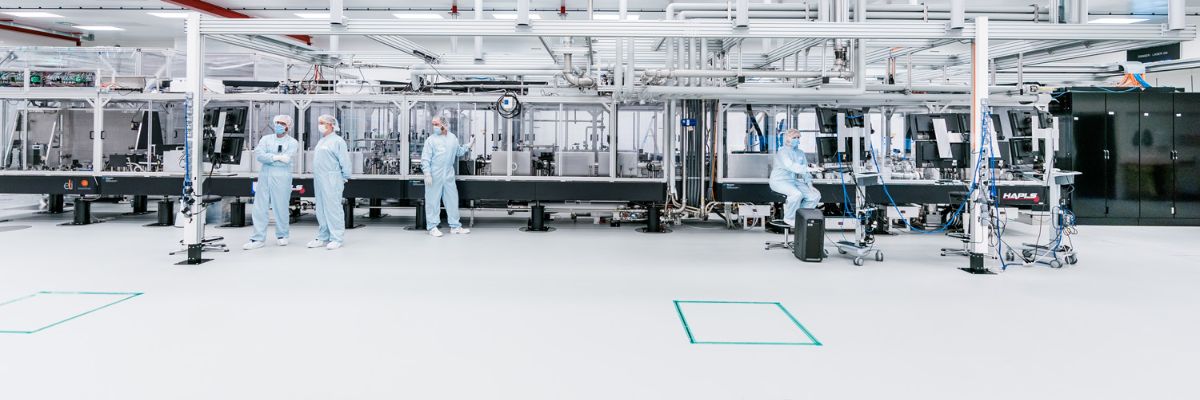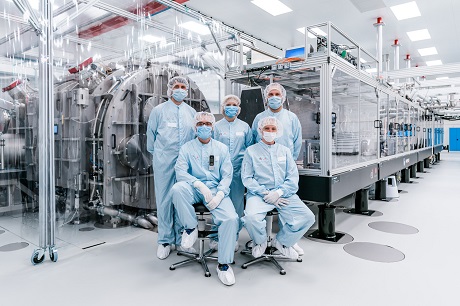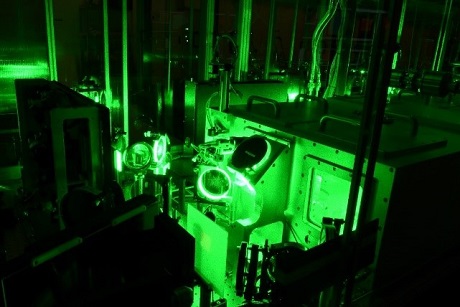
ELI Beamlines reached the highest average power ever demonstrated by a petawatt laser
10. 02. 2021
Operation of the L3-HAPLS laser system in ELI Beamlines Research Centre at 0.5 PW level was demonstrated, consisting in compression of the full energy output pulses currently generated by the laser chain, in the Petawatt vacuum compressor.
In the demonstration run, the L3-HAPLS pump laser was operated at 101 J energy, driving the high-power Ti:sapphire short-pulse amplifier and resulting in 17.7 J of pulse energy at the output of the chain, before entering the vacuum pulse compressor. The energy of the generated output pulses was highly stable with only 0.4 % fluctuations. By accounting for reflectivity of the compressor gratings, compressed pulses with 13.3 J of energy were generated, with duration of 27.3 fs.
This corresponds to peak power of about 490 TW, or 0.49 PW. The long-term performance of the laser was verified previously without the Petawatt vacuum compressor, demonstrating that the laser is stable during continuous operation longer than one hour. Together with the 3.3 Hz repetition rate and pulse duration <30 fs, this is the highest laser peak power ever demonstrated.

The L3-HAPLS laser team
“The L3-HAPLS laser team worked hard during the last year to overcome several operational challenges and to get ready for commissioning experimental campaigns planned for the second half of this year. Finishing these campaigns successfully will be a key step towards opening the high power experimental stations to the user community.” says Josef Cupal, leader of the L3-HAPLS laser team.
The ramping of energy of the full system through the compressor to the 0.5 PW level was done gradually in about 30 steps. After the run, a thorough visual inspection of the diffraction gratings and other optical components inside the compressor was made. No problems were found and the L3-HAPLS system is now ready to start sending the short-pulse high-power beam to the experimental halls.

High-power short-pulse Ti:sapphire Beta amplifier of L3-HAPLS
The L3-HAPLS laser system represents a new generation of diode-pumped, high-energy and high-peak-power laser systems. The laser will serve in many areas of basic and applied research. Its most significant applications include compact laser particle accelerator for new medical methods and short-wave X-ray generation for high-resolution spatial and temporal resolution microscopy for material and medical research. The initial experiments will be focused on Plasma Physics and Ion Acceleration.
L3-HAPLS was designed, developed and constructed by Lawrence Livermore National Laboratory and delivered to ELI Beamlines in June 2017.
A wide coalition of industrial partners was invited to develop the L3-HAPLS laser. This cooperation has enabled a number of technological innovations. The L3-HAPLS laser system uses the world’s most powerful pulsed laser diodes. This effort was awarded by R&D 100 award in 2015.
Text and photo: ELI Beamlines
Read also
- Evolution, alive and well. What lies at the heart of biodiversity?
- From an evolutionary POV, vision has a great benefit–cost ratio, researcher says
- Badminton buzz: Tournament draws 76 athletes from the Academy’s institutes
- Unique reproductive strategy confirmed in another frog species in Moravia
- Hydrochemist Martin Pivokonský on how to improve water and wastewater treatment
- Involved in groundbreaking research, Ukrainian archeologist now works at the CAS
- The first human presence in Europe securely dated to 1.4 million years ago
- The CAS visited by chess grandmaster and Russian opposition activist Kasparov
- The CAS will support scientists whose research is at risk in their home country
- Unravelling the mystery of biodiversity – with a little help from the fruit fly
The Czech Academy of Sciences (the CAS)
The mission of the CAS
The primary mission of the CAS is to conduct research in a broad spectrum of natural, technical and social sciences as well as humanities. This research aims to advance progress of scientific knowledge at the international level, considering, however, the specific needs of the Czech society and the national culture.
President of the CAS
Prof. Eva Zažímalová has started her second term of office in May 2021. She is a respected scientist, and a Professor of Plant Anatomy and Physiology.
She is also a part of GCSA of the EU.